Fort McMurray International Airport
| Fort McMurray International Airport | |||||||||||
|---|---|---|---|---|---|---|---|---|---|---|---|
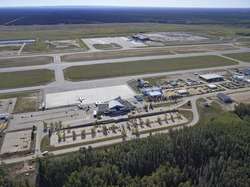 | |||||||||||
|
IATA: YMM – ICAO: CYMM – WMO: 71932 | |||||||||||
| Summary | |||||||||||
| Airport type | Public | ||||||||||
| Owner/Operator | Fort McMurray Airport Authority | ||||||||||
| Serves | Regional Municipality of Wood Buffalo, Alberta | ||||||||||
| Location | Fort McMurray, Alberta | ||||||||||
| Time zone | MST (UTC−07:00) | ||||||||||
| • Summer (DST) | MDT (UTC−06:00) | ||||||||||
| Elevation AMSL | 1,211 ft / 369 m | ||||||||||
| Coordinates | 56°39′12″N 111°13′24″W / 56.65333°N 111.22333°WCoordinates: 56°39′12″N 111°13′24″W / 56.65333°N 111.22333°W | ||||||||||
| Website | flyymm.com | ||||||||||
| Map | |||||||||||
 CYMM Location in Alberta | |||||||||||
| Runways | |||||||||||
| |||||||||||
| Statistics (2014) | |||||||||||
| |||||||||||
Fort McMurray International Airport (IATA: YMM, ICAO: CYMM) is located 7 nautical miles (13 km; 8.1 mi) southeast of Fort McMurray, Alberta, Canada. YMM is the largest airport in northern Alberta. It has daily flights to Edmonton, Calgary, Fort Chipewyan, Vancouver and Toronto through airlines Air Canada, WestJet, McMurray Aviation and Northwestern Air. Sunwing airline used to fly to seasonal vacation destinations in Mexico 2012-2015.[4][5]
The airport is managed by the Fort McMurray Airport Authority, a community-based not-for-profit organization that has operated YMM since 2010.
The airport has seen a significant rise in passengers over the last 10 years due to intense development of the Athabasca oil sands. In 2014, YMM served 1,308,416 passengers, ranking it as the 15th busiest airport in Canada.[6] As a result, a new $258 million airport terminal facility opened in 2014 that can accommodate 1.5 million passengers per year.[7]
Canada Border Services Agency (CBSA) established permanent service at the airport in 2013.[8]
History
Early years
Early 20th-century flights to Fort McMurray were primarily float planes that used the Snye River, a waterway that linked Clearwater River to the larger Athabasca River (private float planes still use the waterway). The first landing strip for light planes was built in 1936 to connect Fort McMurray with Edmonton.
World War Two
In 1942, Canadian Pacific Airlines upgraded the landing strip. That same year, with the United States entering World War Two, the United States Army Air Forces (USAAF or AAF) took over the airfield and made further improvements to service Allied air military operations in the Europe and Pacific war theatres. In 1944, the USAAF transferred custody of the airstrip back to the Canadian Department of Transport (now Transport Canada).
Post-war years
The Department of Transport continued to make improvements to the airfield, lengthening the runway to 1,829 m (6,000 ft) and paving it with asphalt in 1948. Pacific Western Airlines took over management of the airport from the late 1950s to 1960s. In 1962, the airline company built the first permanent air terminal building.
Transport Canada continued to operate and make improvements to the airport from the 1960s to 1990s. The first permanent control tower was commissioned in 1981 and a larger 3,000 m² (32,293 sq ft) terminal opened in 1986 to accommodate 250,000 passengers per year.
Creation of airport authority
In 1999, the Regional Municipality of Wood Buffalo created the Regional Airport Commission to take over management of the airport from Transport Canada. Ongoing development in the Athabasca oil sands led to massive passenger growth and aircraft traffic. Higher demand made it necessary to expand, including extending the runway to its current length of 2,286 m (7,500 ft) in 2007.
In 2009, the Regional Airport Commission incorporated an airport authority. The first airport authority Board was formed in 2010 to become the Fort McMurray Airport Authority (FMAA), which presently manages YMM.
Recent developments
YMM became the fastest-growing airport in Canada in the early 2010s, with air activity records shattered in 2013 and 2014. YMM served 1.2 million passengers in 2013, and 1.3 million passengers in 2014. YMM went from the 16th busiest airport in Canada in 2011 to 15th busiest in 2014.[9]
Many passengers included people from outside Canada – particularly foreign workers for the Athabasca oil sands. To make it easier for work and leisure air travel, the Canada Border Services Agency (CBSA) created a permanent border entry into Canada at YMM in 2013.[8]
Larger passenger numbers created crowded conditions at the original terminal. The FMAA built a new $258 million airport terminal that was five times larger than the original and able to accommodate up to 1.5 million passengers per year. The new terminal was opened to passengers on June 9, 2014.[7]
The airport temporarily ceased operations on May 4, 2016 due to an out-of-control wildfire in Fort McMurray. Some minor damage occurred to outer structures, but the primary buildings remained intact.
Terminals
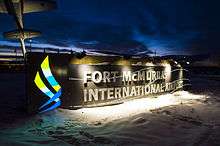
YMM has two terminals. The large main terminal (opened in 2014) is located on the south side of the runway and is used for commercial passenger service. The original terminal (opened in 1986) is located on the north side of the runway and was renovated and re-opened in 2014 to exclusively serve workforce charters, corporate flyers, and cargo.
Main Terminal
The main terminal building serves commercial passengers and houses CBSA where international travellers and returning Canadians enter the country. The building is approximately 15,000 m² (160,000 sq ft.), or the equivalent size of 2.5 Canadian football fields. The terminal has four passenger bridges and eight aircraft parking stands.[10]
The terminal has many services for passengers, including:[11]
- a customer service and visitor information centre
- a public observation area with interactive learning exhibits
- a children’s play area
- a naturally heated courtyard with a travelling pet relief area
- free wireless service and USB charging stations in all passenger lounge seats
Concessions
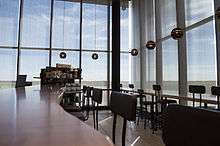
The main terminal has 16 retail and food and beverage outlets, including casual dining, fine dining, convenience stores and specialty shops on both sides of security. Some of the major brands are:[12][13]
- Best Buy Express
- Burger King
- Earls Kitchen + Bar
- Famoso Neapolitan Pizzeria
- Jugo Juice
- Jeckov Kanani Skin Care & Accessories
- Mary Brown's Famous Chicken & Taters
- Nicholby’s Convenience Stores
- Starbucks
- Subway
- Tim Hortons (opening October 1)
On April 22, 2015, YMM received first place in the “Best Food & Beverage Program – Medium/Small Airport” category at the Airports Council International – North America (ACI-NA) Excellence in Airport Concessions Awards.[14]
North Terminal
The North Terminal was originally built for both commercial and private passenger services. After the opening of the new main terminal in 2014, the building was renovated and re-opened as the North Terminal to serve workforce charters, corporate fliers and cargo.[15]
The North Terminal supports about 250,000 workers a year, or 20 per cent of all YMM passengers annually.[16] Charter carriers, including Canadian North, Enerjet, Flair Air and North Cariboo Air operate through the terminal. The terminal has retail, food and beverage, and car rental services. It also handles air cargo operations such as a dedicated cargo depot, storage and sorting space as well as ramp space for cargo aircraft.
Architecture
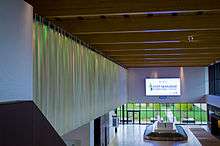
The interior of YMM’s main terminal has a unique northeastern Alberta theme, emphasizing the boreal forests that cover the Wood Buffalo region’s landscape and the green, blue and gold colours of the aurora borealis that are prominently seen in the night sky of the Canadian north.
The main terminal architecture was designed by office of mcfarlane biggar architects + designers inc (OMB) of North Vancouver, British Columbia. The design was recognized as one of 11 recipients of the 2013 Canadian Architect Award of Excellence, for embodying qualities of innovation and overall design excellence.[17]
Pine roof
The most striking feature is unique laminated pine wood beam used to support the roof, which is the largest of this type of material in North America. Some 644,663 kg (1.4 million lbs) of pine wood material was used to build the roof using engineered timber reclaimed from forested areas in interior British Columbia that were devastated by pine beetle infestation in the mid-2000s. The exposed mass timber structure complements the other refined yet durable materials used for the terminal’s interior, including triple glazed windows, terrazzo flooring and acoustic wood panels.
Public art
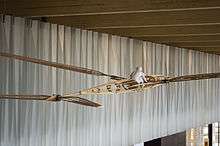
YMM has a collection of art by artists locally and across Western Canada that showcase the unique look and character of Fort McMurray and the Wood Buffalo region.[18] These art pieces include:
- the suspended sculpture “Daedalist” by David Robinson of Vancouver
- the photographic collage “Waterways” by Liz Ingram of Edmonton
- the paintings “Lasting Impression” and “Sky Explorer” by Lucas Seaward of Fort McMurray (which uses bitumen as part of the palette)
- the painting “Sky Dance” by Amy Keller-Rempp of Fort McMurray
- the painting series “Utopia” by Jane Ash Poitras of Fort Chipewyan
The Northern Lights mural in the arrivals hall features the aurora borealis and boreal forests for the Wood Buffalo region, and unites all the other thematic features of the main terminal.
Observation area
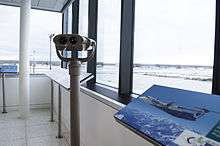
YMM has an interactive public observation area with educational exhibits showcasing Fort McMurray’s aviation history.[19] These exhibits include:
- a mural of famous pilots that operated in northern Alberta in the early to mid-20th century
- a rotating historical artifacts collection of aviation equipment and heirlooms donated by the Fort McMurray Historical Society, the Alberta Aviation Museum and the Canadian Aviation Hall of Fame
- interactive video screens that take visitors through a virtual timeline of northern Alberta’s aviation history
- telescopes for viewing airfield activity
Exterior art pieces

A trident of light towers varying between 5 m to 7 m (18 to 25 ft) in height can be seen by passengers before the main terminal entrance. The three towers are illuminated after sunset with colors similar to the aurora borealis. YMM also has two 9 m (30 ft) illuminated welcome signs with a replica of a Canadian Forces Snowbirds aircraft.[20]
Accessibility
The new YMM airport terminal is outfitted with automatic doors, ramps and lifts, and the food court and passenger lounges have barrier-free seating areas.[21] Accessible parking stalls are located closest to the main terminal, with users required to display a disable person or veteran licence plate, or a disabled parking placard in the windshield.
Persons with wheelchairs or other mobility-assist devices can arrange for special assistance with airlines. Ramps and curb cuts are available at both arrivals and departures, and an enlarged drop-off stall for wheelchairs is located on the departures level.
YMM has washrooms accessible to passengers with either limited mobility, have infants and young children, or require a companion. Washrooms have screen walls in place of doors, stalls and sinks that are accessible to everyone, low countertops and automated faucets and paper towel dispensers. The terminal has a companion care rest room in the arrivals hall for travellers needing companion assistance. Family rooms are located across from all common washrooms.
Certified service animals such as seeing-eye dogs are allowed in the terminal. The outdoor courtyard is also a pet relief area, equipped with plastic bags and animal waste disposal receptacles.
Visitor and Customer Information Centre
YMM hosts a Visitor and Customer Information Centre through partnerships with the Regional Municipality of Wood Buffalo and Fort McMurray Tourism.[22] The centre is in the arrivals hall and available to help passengers. Some of the services offered include finding accommodations, securing transportation or assisting visitors in planning their stay while they are in Fort McMurray.
Community involvement
YMM’s Community Investment Program (CIP) helps community organizations in three core areas:[23]
- Youth – programs that provide educational opportunities to youth
- Aviation Education and History – programs that preserve and educate about northern Alberta’s rich aviation history
- Canada’s Military – programs that support men and women who serve or have served in the Canadian Armed Forces
In 2014, CIP provided $200,000 in funding to organizations including the Wood Buffalo YMCA, the Royal Canadian Air Cadets, and the Wood Buffalo Food Bank. YMM also encourages its employees to volunteer in their community through the employee volunteer matching program.
Sustainability
YMM has many energy-saving and sustainable features installed in the new airport terminal that increase the building’s lifespan while reducing its carbon footprint.[17]
The main terminal’s exterior is also very robust, designed to withstand the northern winter climate. These exterior materials include pre-weathered steel panels and pre-cast panels as well as layers of thick, airtight insulation to minimize excess heat loss.
The main terminal is outfitted with several energy-saving features, including:
- in-floor radiant heat for warming
- passive ventilation for cooling
- heat recovery systems that recycle excess heat back into the building
- high windows and ceilings that allow in ample natural light
- flexible overall layout for changing airline and security requirements
Airlines and destinations
Passenger
| Airlines | Destinations |
|---|---|
| Air Canada | Toronto–Pearson |
| Air Canada Express | Calgary, Edmonton, Vancouver |
| Canadian North | Charter: Calgary, Comox, Vancouver |
| McMurray Aviation | Fort Chipewyan |
| Northwestern Air | Edmonton, Fort Chipewyan |
| WestJet | Calgary, Edmonton, Toronto–Pearson |
| WestJet Encore | Calgary, Edmonton, Vancouver |
Cargo
Over half of cargo at YMM is handled by dedicated air cargo carriers while Air Canada and WestJet carry the remainder on scheduled passenger flights. The air cargo facility in the short-term will operate out of the North Terminal. A new third-party air cargo building with an expanded apron is planned to be built east of the North Terminal.[24]
Ground transportation
Taxi/shuttle
YMM has many taxi/shuttle services passengers can use, including:[25]
- 24-hour licensed taxi service, including wheelchair accessible units
- limo services (luxury sedans, SUVs, stretch limos)
- free RIDE & FLY shuttle service to parking spaces every 15 minutes
- private shuttle service to hotels or worksites, based on individual arrangements
Six major rental car brands also operate at YMM:
- Avis
- Budget
- Driving Force
- Enterprise
- Hertz
- National
Transit

The Wood Buffalo Transit operates a bus route (Route 11) between downtown Fort McMurray and YMM seven days a week, with stops at eight major hotels and at Keyano College. The bus stop is located curbside on the arrivals level.[26]
Parking
YMM offers over 2,200 parking stalls equipped with power outlets, including 430 short-term parking stalls and over 1,400 long-term parking stalls.[27]
Expansion
On March 27, 2015, the FMAA received $25 million in funding from the Canadian government, covering a third of the $75 million budgeted to extend the main runway from 2,286 m to 2,743 m (7,500 ft to 9,000 ft) and expand existing aprons for larger aircraft. The Main Terminal building will also be expanded to include two additional gates. The Regional Municipality of Wood Buffalo has also $25 million committed to support the project, with the FMAA responsible for the remaining one-third of the budget.[28]
Future expansion plans for the airport include:
- a hotel attached to the main terminal
- a new air cargo facility
- a quick turnaround car rental services facility
- a new control tower
- a shared facility for Airport Rescue and Fire Fighting (ARFF) services and airport maintenance
FBOs
YMM has two fixed-base operators that service aircraft:
Other facilities
YMM has 10 essential aviation services operating on its property, including:[31]
- avionics
- air ambulance
- charter services
- corporate services
- search and rescue
- aircraft maintenance
- firefighting services
- helicopter services
- flight schools
- private and recreational flying
Commercial land development
YMM has a total 1,267 acres (512 hectares) of land available for commercial development, divided into seven commercial parks. Uses of the land may include:[32]
- gas stations
- offices
- warehouses
- light manufacturing plants
- public utilities
- transportation services
See also
References
- ↑ Canada Flight Supplement. Effective 0901Z 15 September 2016 to 0901Z 10 November 2016
- ↑ Synoptic/Metstat Station Information
- ↑ Fort McMurray Airport Statistics
- ↑ "YMM: Route Map".
- ↑ "YMM: Airlines".
- ↑ "Fort McMurray International Airport Breaks Record with over 1.3 Million Passengers in 2014" (PDF).
- 1 2 "Fort McMurray to Open New International Airport Terminal".
- 1 2 "Fort McMurray Airport Named Official Port of Entry with Core Customs".
- ↑ "Fort McMurray International Airport Breaks Record with Over 1.3 Million Passengers in 2014" (PDF).
- ↑ "YMM: New Terminal".
- ↑ "YMM: Passenger Services".
- ↑ "YMM: Shop, Dine, Stay".
- ↑ "YMM: Concessions".
- ↑ "Fort McMurray International Airport Wins First Place for Best Food & Beverage Program".
- ↑ "YMM: North Terminal".
- ↑ "FMAA Opens Renovated and Repurposed North Terminal".
- 1 2 "YMM: Media: Completed Terminal Project".
- ↑ "YMM: Art at YMM".
- ↑ "YMM: Observation Area".
- ↑ "YMM: The YMM Welcome".
- ↑ "YMM: Accessibility".
- ↑ "YMM: Information and Assistance".
- ↑ "YMM: Community Investment Program".
- ↑ "YMM: Air Cargo".
- ↑ "YMM: Getting Around".
- ↑ "RMWB Transit - Route 11".
- ↑ "YMM: Parking".
- ↑ "News Release: Government Partnership to Expand Fort McMurray International Airport".
- ↑ Universal Aviation
- ↑ Executive Flight Centre
- ↑ "YMM: General Aviation".
- ↑ "YMM: Land Development".
External links
| Wikimedia Commons has media related to Fort McMurray International Airport. |
http://www.flyymm.com/media/news-releases/fort-mcmurray-international-airport-update
- Past three hours METARs, SPECI and current TAFs for Fort McMurray International Airport from Nav Canada as available.
- Page about this airport on COPA's Places to Fly airport directory